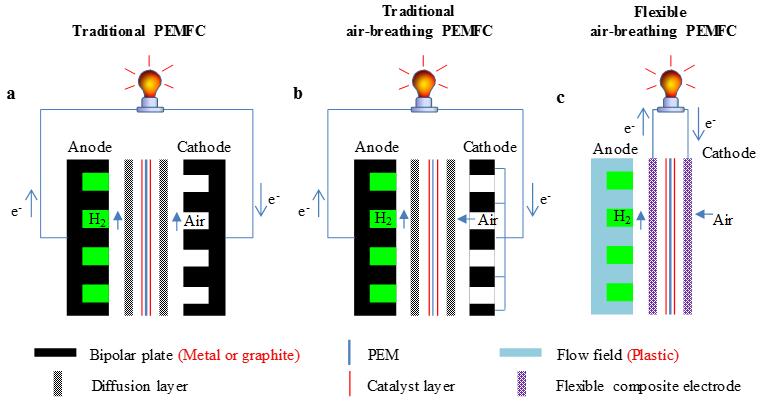Proton exchange membrane fuel cell (PEMFC) has numerous advantages, such as high energy density, high conversion efficiency, environmental friendliness, and compact design. However, traditional PEMFCs are usually too heavy, rigid, and bulky to be used in flexible devices.

Structures of different PEMFCs: (a) Structure of traditional PEMFC. Air or O2 is pumped into PEMFC. (b) Structure of traditional air-breathing PEMFC. Air naturally diffuses into PEMFC. (c) Structure of flexible air-breathing PEMFC in this research. Air naturally diffuses into PEMFC. (Image by SINANO)
In an effort of preparing fuel cells more portable and compliant for wearable application. ZHOU Xiaochun's group from Suzhou Institute of Nano-tech and Nano-bionics (SINANO), Chinese Academy of Sciences has designed and successfully prepared a lightweight and flexible, self-breathing PEMFC. Related results were published in ACS Nano under the title “Flexible and Lightweight Fuel Cell with High Power Density”.
The researchers designed a novel composite electrode by stacking a highly flexible and micro-perforated CNT membrane with carbon paper, while replacing the plate on the anode side with a light, flexible and cheap plastic membrane. Above all, the PEMFC has not only high power density but also favorable stability. The main reason is that the composite electrode functioned as an efficient current collector while the light plastic membrane on the anode side operated as the follow field for the hydrogen (fed through a plastic tube) .

Comparison of traditional and flexible air-breathing PEMFC. (a) Photograph of traditional and flexible air-breathing PEMFC. (b) Enlarged photograph of flexible air-breathing PEMFC. (c) Polarization curves shows flexible air-breathing PEMFC has a larger current density and peak power density. (Image by SINANO)
This strategy greatly reduces the volume and weight of fuel cells. They reported a 1X1 cm2 flexible self-breathing PEMFC as light as 0.065 g and as thin as 0.22 mm in the paper. At the meantime, this new PEMFC exhibits an outstanding specific volume and weight power densities as high as 5190 W L-1 and 2230 W kg-1, which are several orders of magnitude higher than that of conventional air-breathing PEMFCs and even higher than conventional PEMFCs.
Additionally, the novel air-breathing flexible PEMFC exhibits an excellent mechanical and power output stability. The researchers built a 4 cm long and 1 cm wide flexible PEMFC, and then they evaluated the flexibility through the times of bending, angles of bending and twisting. All the three operations have little effect on the performance of the PEMFC by comparing the change of peak power density. Besides, after being bent 600 times at 0.6 V, the flexible PEMFC discharge performance only decayed 10.9%. The results show that, as an electric output device, the flexible PEMFC has preeminent stability.
In real applications, fuel cells need to adapt to a variety of working environments to be used as energy supply devices. Especially in aerial environments, fuel cells may be subjected to extreme forces that can destroy them, such as being dropped from a height. Therefore, we simulated these forces by dropping the flexible PEMFC from as high as 30 m. The flexible PEMFC retained its structure and performance very well after falling 5 times.

Application demonstrations of flexible PEMFC stacks. (a) The 4x1cm2 fuel cells under bending test. (b) 53-LED lights powered by a flexible PEMFC stack with 4 single cells while bent. (c) Charging a mobile phone with a flexible PEMFC stack of 8 single cells.(Image by SINANO)
In order to show the practical use of this flexible air-breathing PEMFC, the researches expect those could be stacked to power small electrical appliance as LED or mobile phones. A flexible PEMFC stack consisting of eight single PEMFCs can power a mobile phone. The stack is lightweight (3.70 g), small (9 cm length and 3.5 cm width), thin (1 mm), and occupies a small volume (3.15 cm3).
The research exhibits that it is possible to make PEMFCs that are light, flexible and suitable for flexible-device applications. This innovative flexible PEMFC research may advance the PEMFC field, because flexible PEMFCs can achieve high specific power density with small size, small volume, and light weight at considerably lower cost while being far easier to mass produce.
Contact Information:
Prof. ZHOU Xiaochun, Suzhou Institute of Nano-Tech and Nano-Bionics, Chinese Academy of Sciences
Email: xczhou2013@sinano.ac.cn
Links:
Website of ZHOU Xiaochun's group: http://www.mscatalysis.net/
Literature: Flexible and Lightweight Fuel Cell with High Specific Power Density (ACS Nano, 2017, 11 (6), pp 5982–5991)
downloadFile
